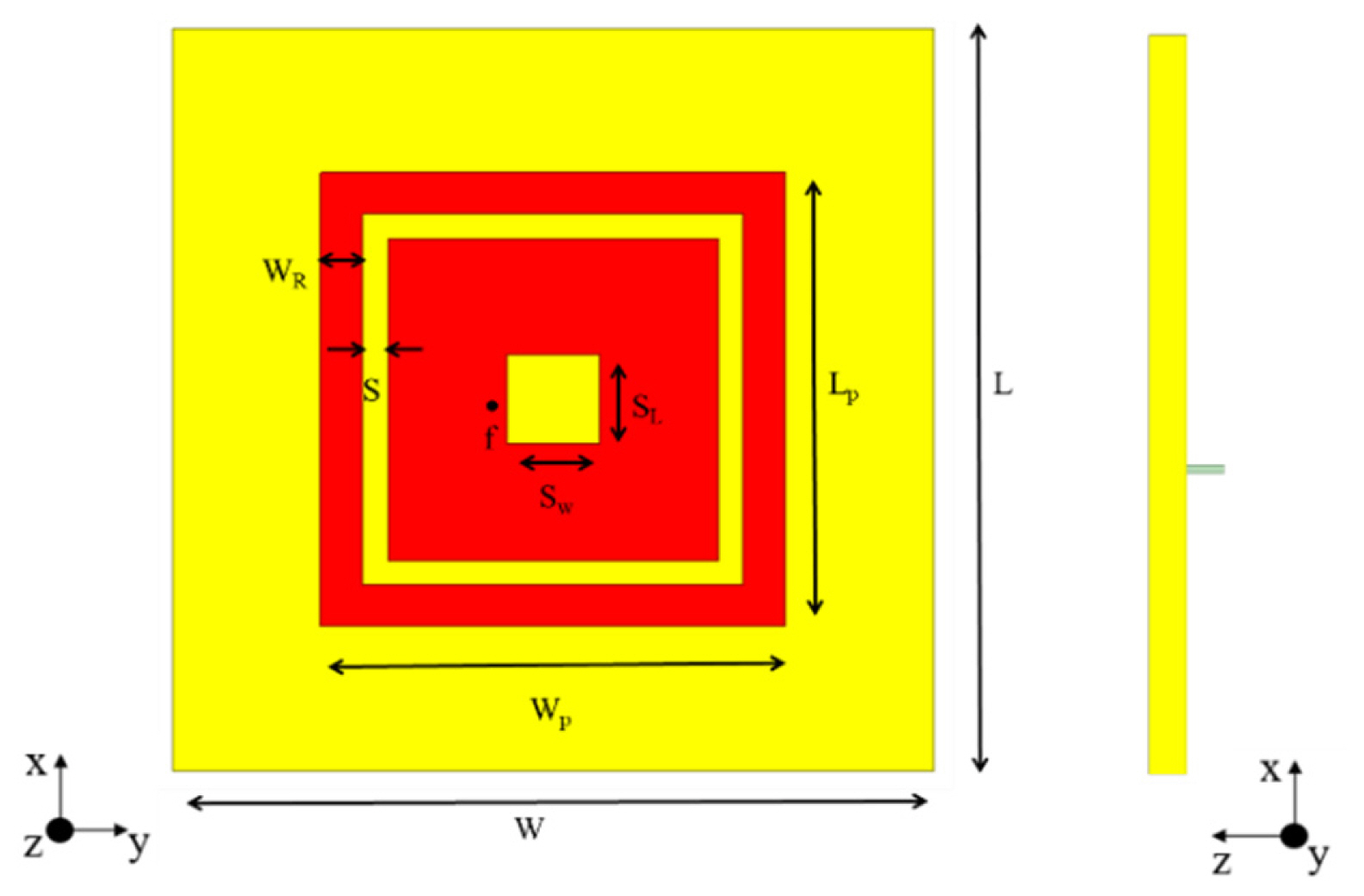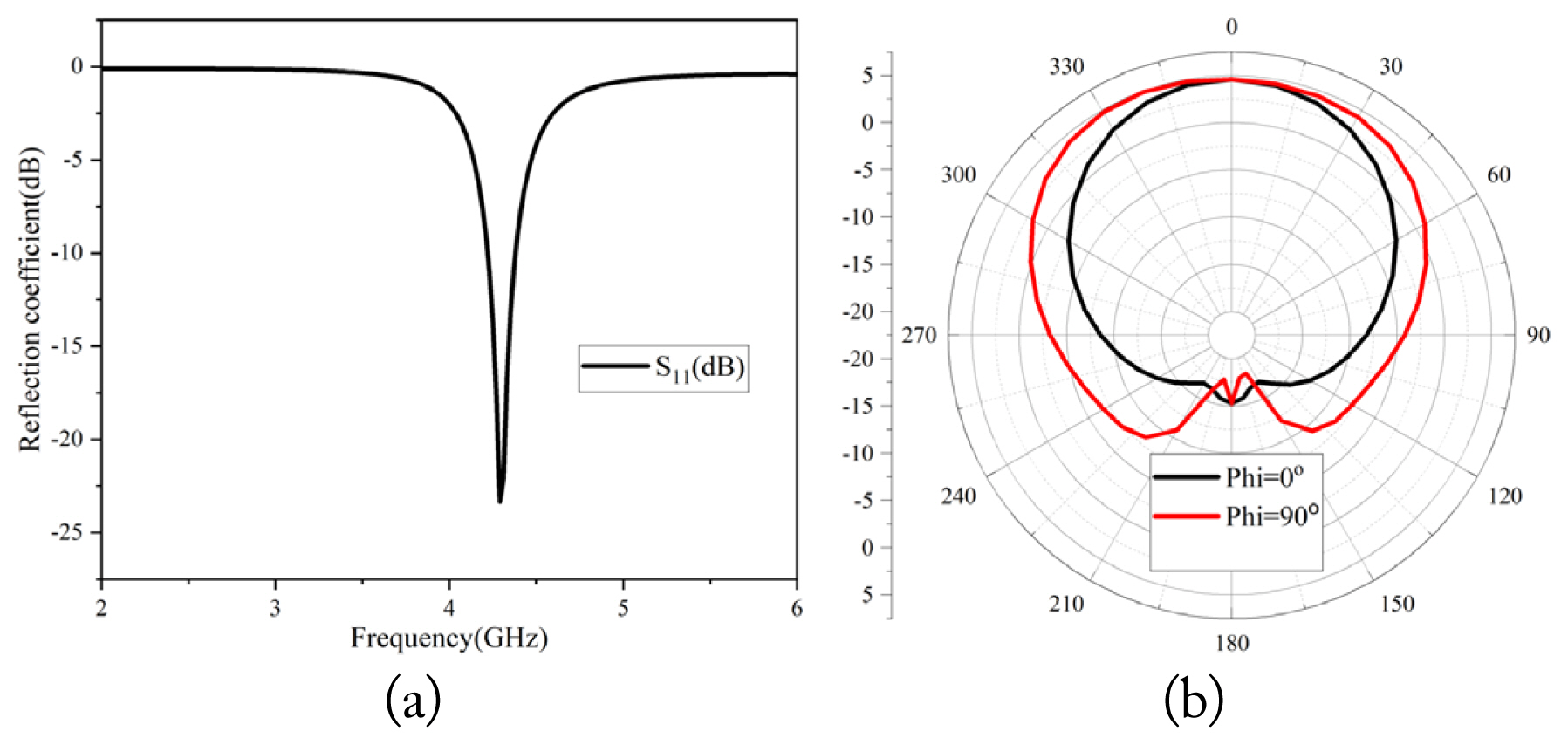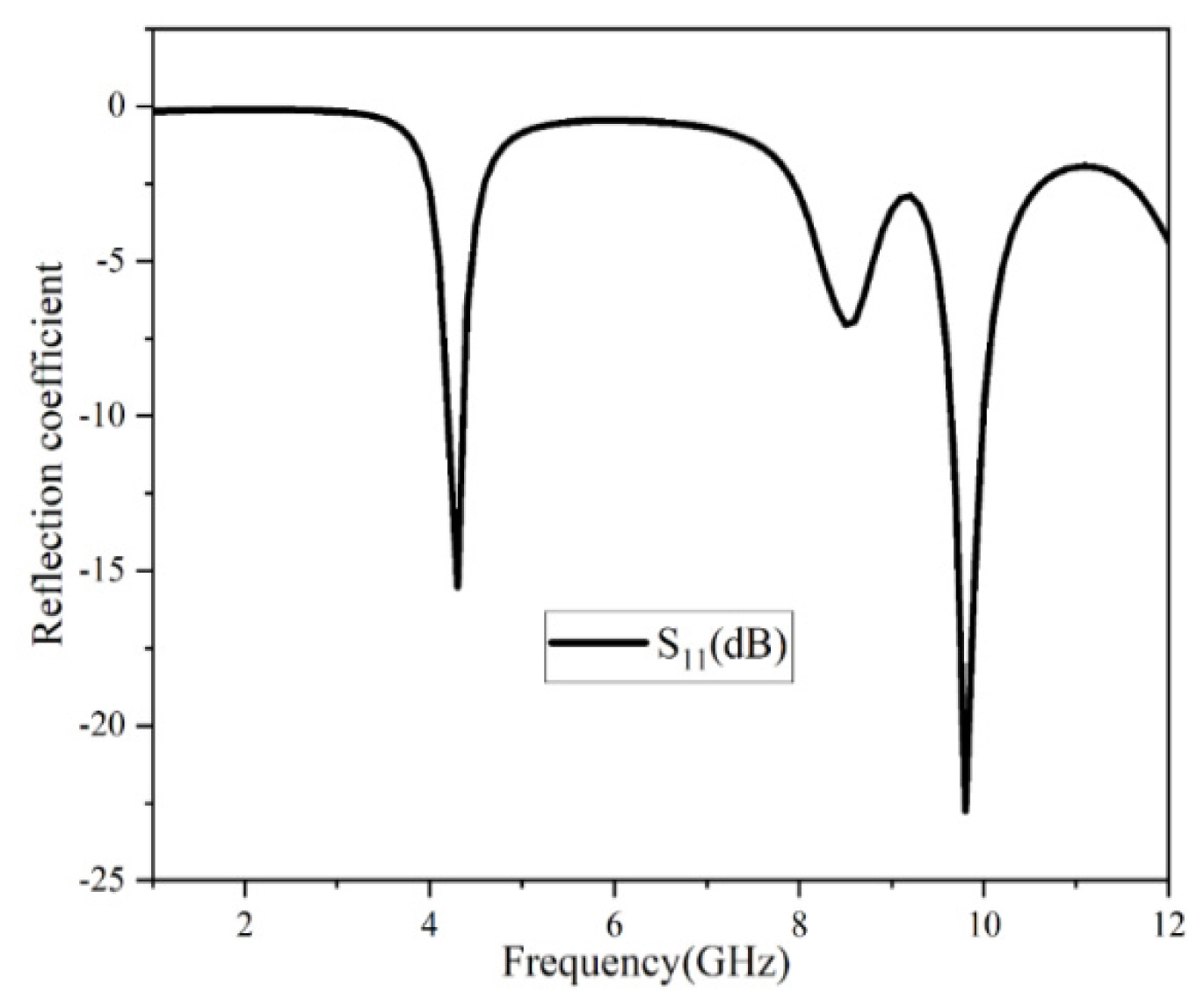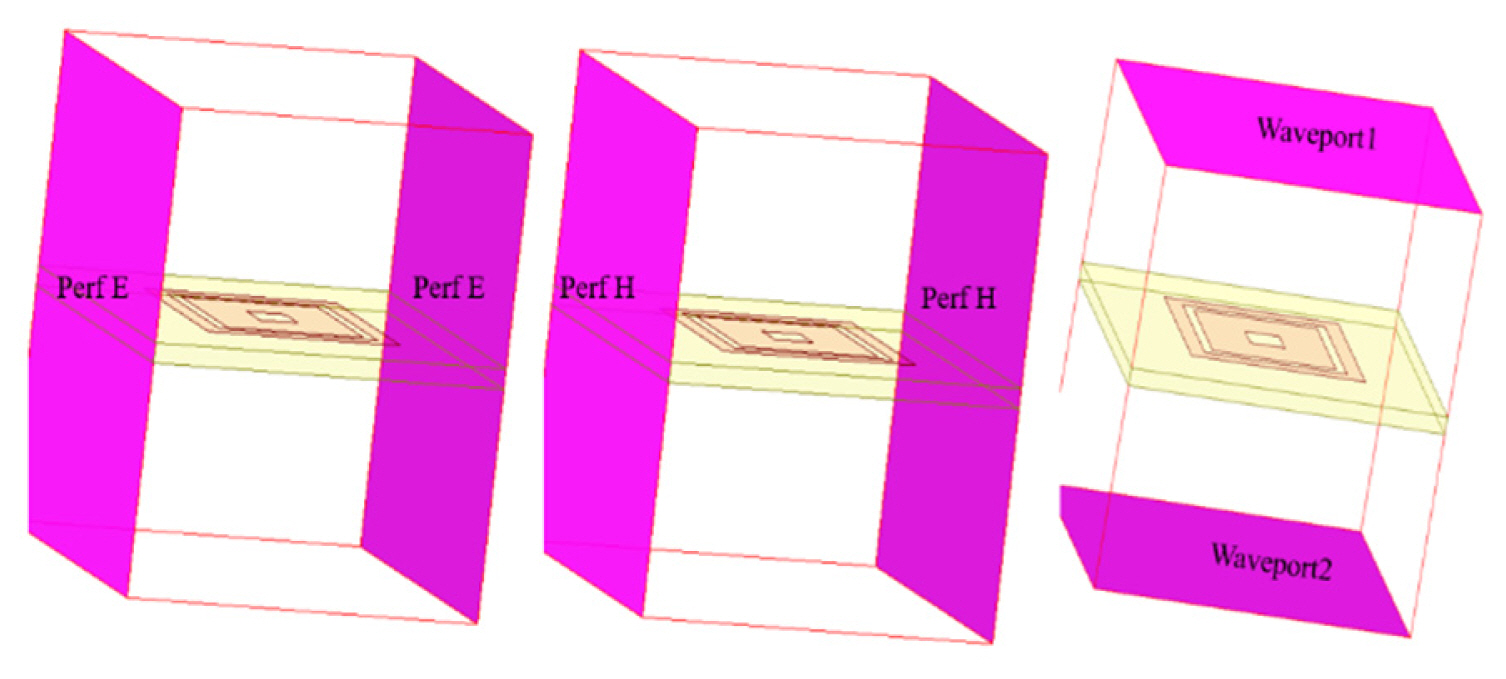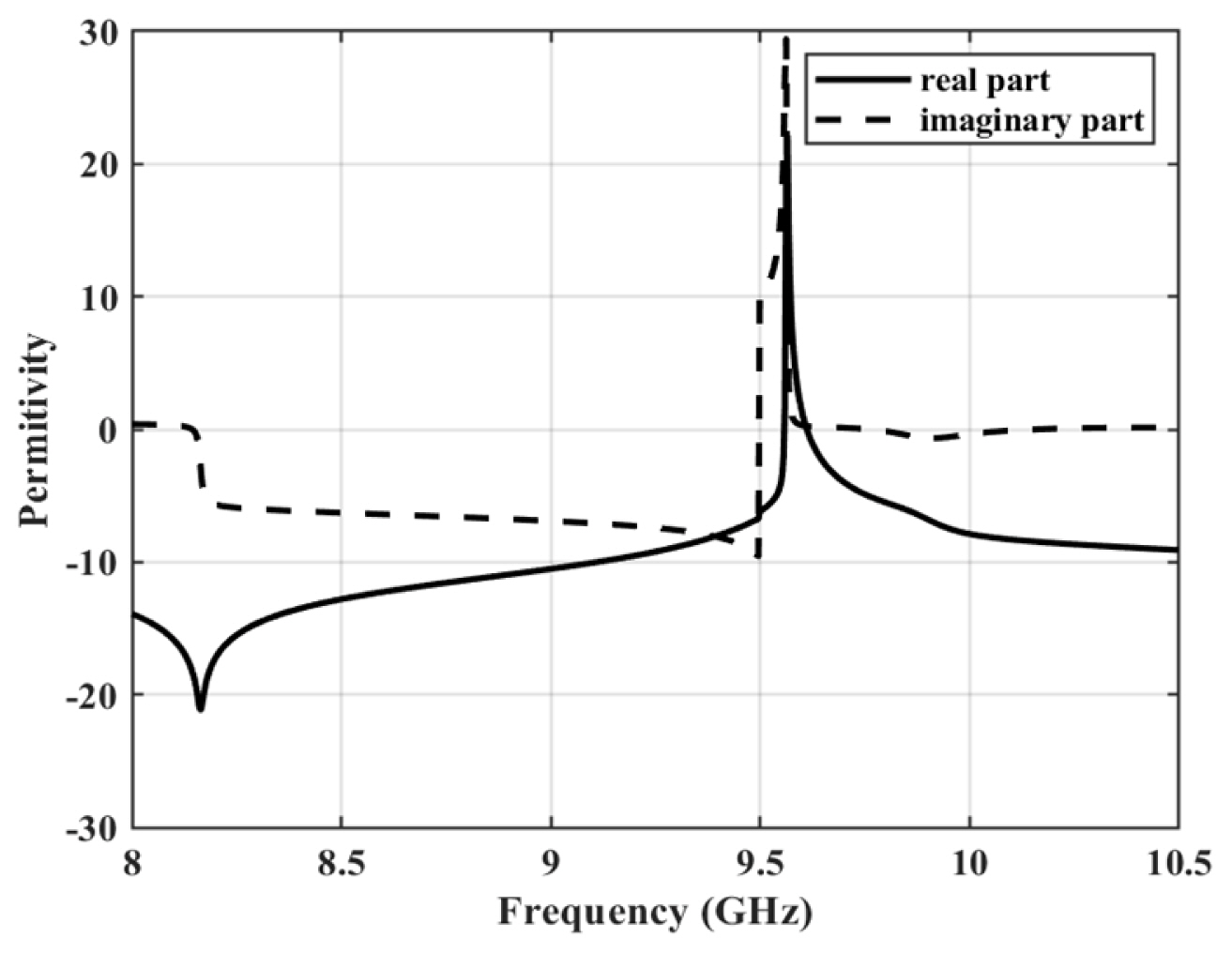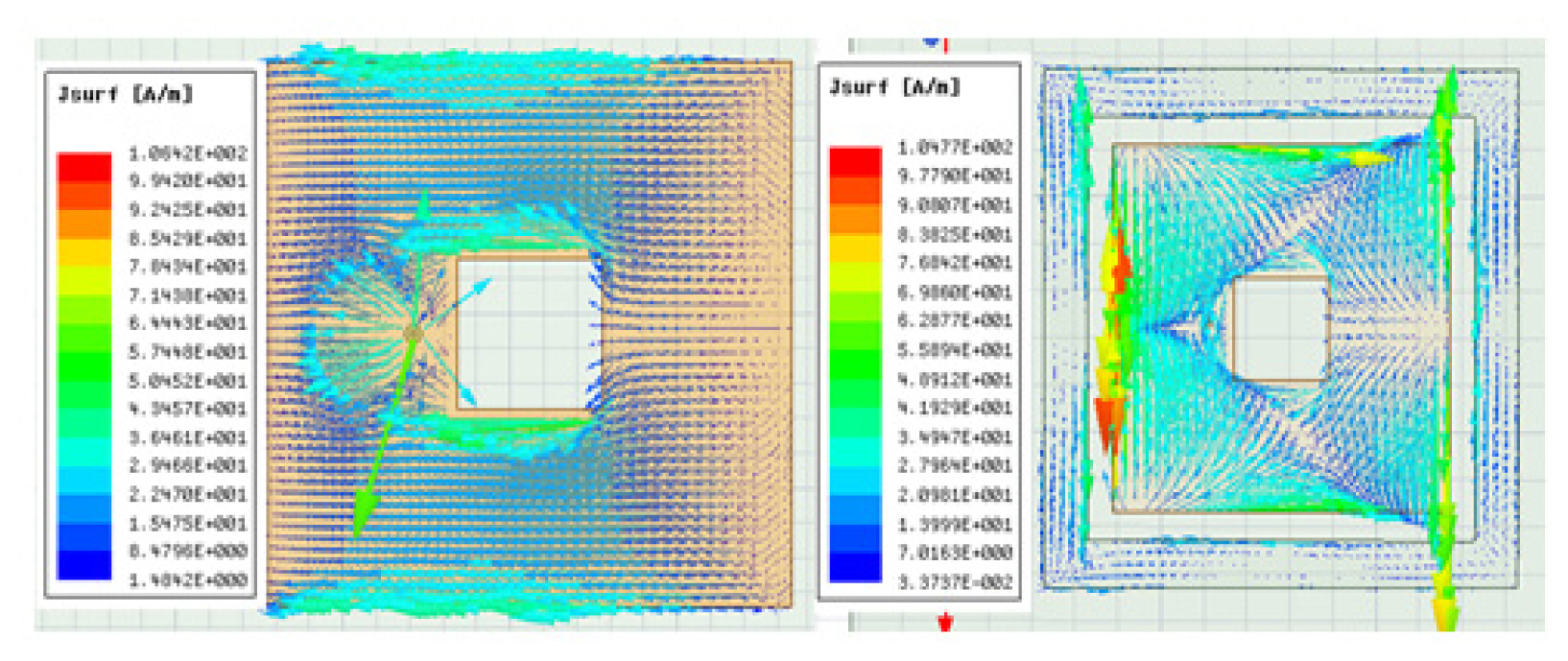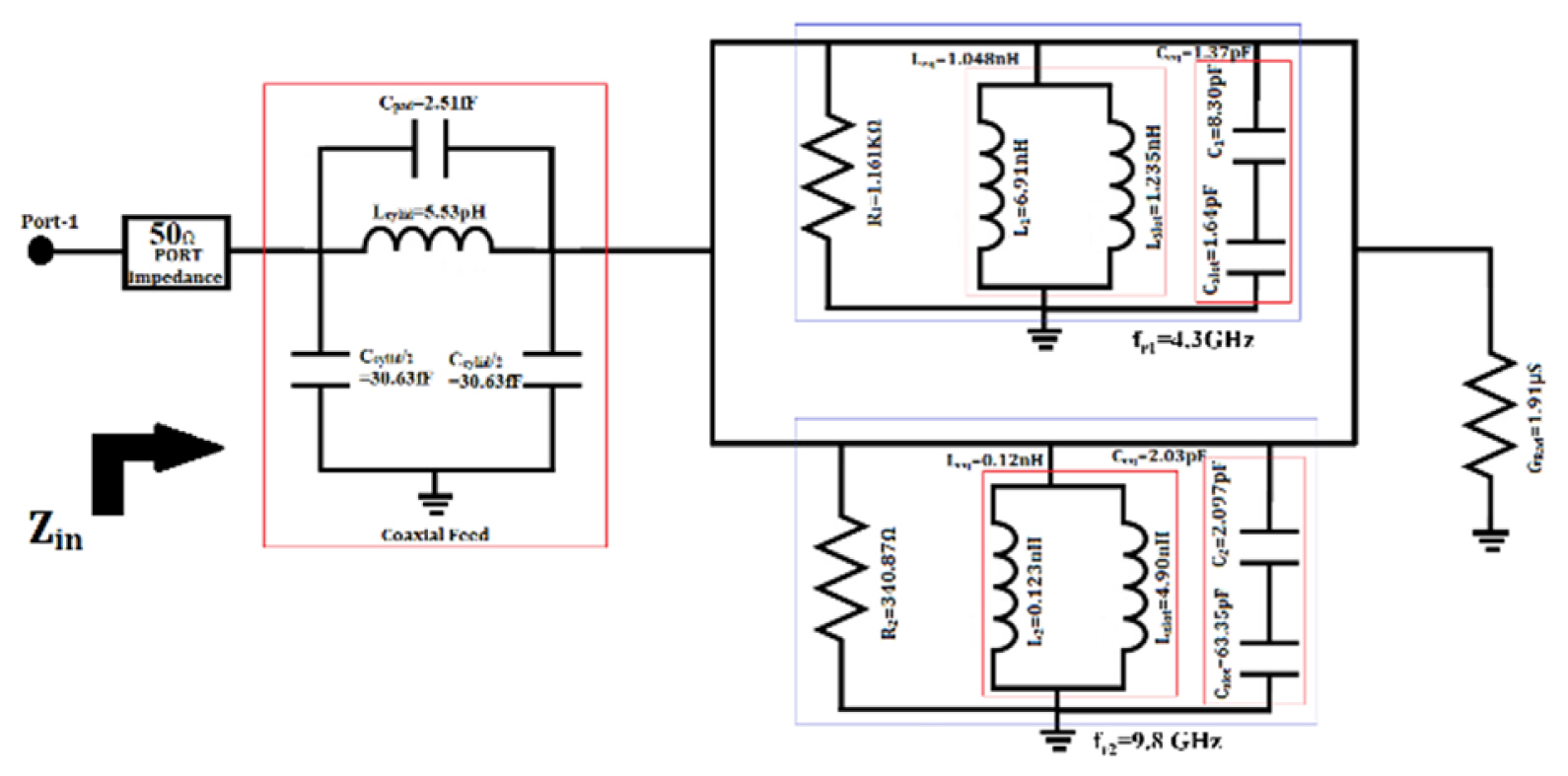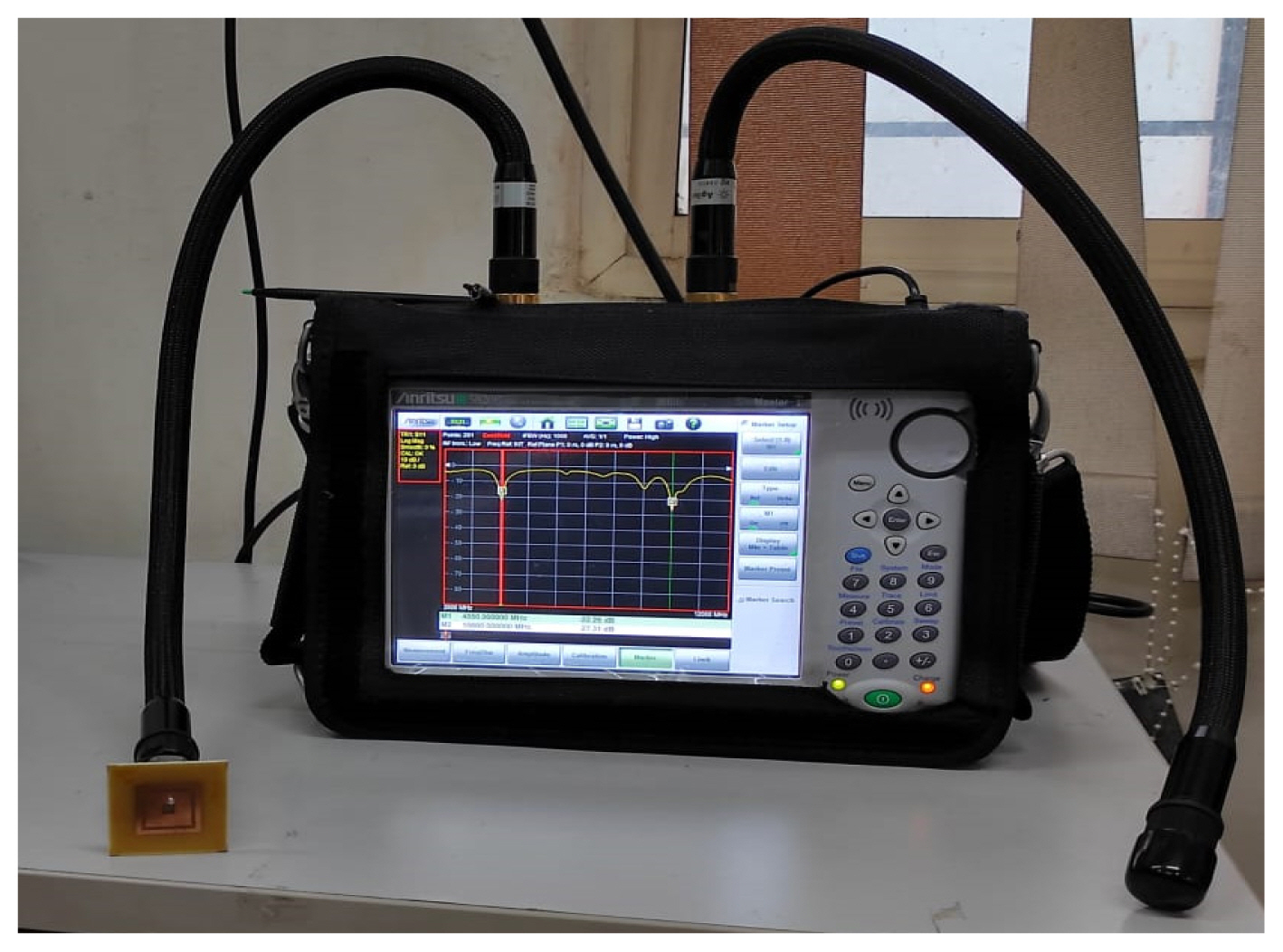 |
 |
- Search
| J. Electromagn. Eng. Sci > Volume 23(6); 2023 > Article |
|
Abstract
A dual-band antenna with pattern similarity using the energy-squeezing mechanism of an epsilon-near-zero (ENZ) metamaterial is designed, and experimental results are presented with simulated data. To achieve high gain and pattern similarity, a waveguide-based ENZ metamaterial property is adopted in a planar microstrip form at the upper band. The designed dual-band antenna is resonating at 4.3 GHz and 9.8 GHz frequencies with the desired radiation pattern. A metamaterial unit cell with ENZ characteristics at 9.8 GHz is designed to improve the antenna’s performance. The permittivity and permeability of the unit cell are characterized using the Nicolson–Ross–Weir method. By adding a square ring structure, the antenna geometry exhibits ENZ characteristics. Using the ENZ material’s energy-squeezing mechanism, a 12-dB gain improvement is achieved in the upper band without affecting the lower band radiation characteristics without increasing the complexity. It can be used in C- and X-band applications, such as mobile, military, defense, and radar communication. The dual-band antenna with ENZ material is fabricated, and the measured results show a good match with the simulated results. The proposed antenna size at 4.3 GHz is 0.58λ × 0.58λ × 0.02λ.
With recent communication requirements, the demand for multifunctional and highly efficient antennas has increased. The current trend is to create devices for wireless communication systems that have high bandwidth, gain, and built-in multi-resonance. To achieve this high performance and miniaturization, the present researchers propose microstrip-based antennas.
Microstrip patch antennas are widely used in innumerable applications because they are low cost, low profile, easy to fabricate, and low weight [1]. However, they suffer from issues such as less bandwidth and low gain. Microstrip antennas are suitable for creating miniaturized multiband antennas by incorporating slots and patches into existing structures [2–5]. Thus, a number of technical approaches have been applied to patch antennas to make efficient candidates for modern communication applications. Asymmetric M-shaped antennas [6], H-shaped slot antennas [7], and other microstrip antennas with dual-band and triple-band properties are available in the literature. For dual-band applications, defected ground structure (DGS) antennas have been demonstrated [8]. Most multiband antennas have a non-uniform radiation direction at both bands [9–11]. This will detriment dual-band antenna system performance.
These drawbacks have prompted the development of metamaterials, which are purposefully constructed structures with unique electromagnetic properties that are not seen in nature.
These metamaterials can be used in planar technology to overcome numerous microstrip antenna problems. Due to their extraordinary electromagnetic properties, metamaterials are widely used in antenna design, particularly in the realization of multi-band, ultra-wide-band, and high-gain antennas. In most cases, the metasurface structure is loaded onto the antenna as a radiating element. Both double-negative materials [12, 13] and epsilon-near-zero (ENZ) materials have gained the attention of researchers because of their extraordinary characteristics, such as super coupling, tunneling, and squeezing of electromagnetic energy [14, 15]. Super coupling, energy squeezing, and tunneling effects are the most impressive phenomena of ENZ materials for tailoring electromagnetic energy direction.
In [2, 16–18], most multi-band antennas have omnidirectional patterns. In this paper, we present the design of a directional dual-band antenna based on the complementary structure of a microstrip patch antenna with pattern similarity. We demonstrate a novel application of ENZ material properties on a dual-band antenna to stabilize the gain of the upper band.
This work concentrates on the design of a high-performance dual-band antenna at 4.3 GHz and 9.8 GHz with optimum gain. To achieve pattern similarity at the upper band with respect to the lower band, a novel energy-squeezing mechanism is applied to the design. In the design process, a 4.3-GHz microstrip patch antenna is designed with a 4.2-dB gain. To convert it to a dualband, we introduce a slot with respect to 9.8 GHz to create a resonance at that frequency with a null radiation pattern in boresight. Many of the dual-band antennas in [19] have an issue with a radiation pattern that is not comparable at both bands, limiting the identical usage of the antenna at both bands. The overall size of the proposed antenna is less 0.58λ × 0.58λ × 0.02λ compared with the existing designs in the literature [2, 16, 20].
Electromagnetic source excitation can be tailored using ENZ metamaterials. In this paper, the application of these media to alter the phase of arbitrary sources’ radiation patterns is illustrated in a microstrip patch antenna. ENZ material energy-squeezing capability was first demonstrated in waveguides. Experimental verification of ENZ material properties in waveguides is presented in [15] by introducing waveguide bends and filling those waveguides with ENZ material. An illustration of the waveguide problem with the ENZ material is shown in Fig. 1.
The model contains two metallic parallel-plate waveguides combined with an ENZ channel. The two regions enclosed by the parallel metallic plates are full of air. The spacing between the parallel plates is a1 and a2 for regions 1 and 2, respectively. An arbitrary shape is considered for the ENZ material section, with Ap as a cross-sectional area, and the inward and outward faces of the ENZ channel are assumed to be vertical to the perfect electric conductor (PEC) walls, as shown in Fig. 1. Using the theory developed in [14], we can compute the scattering parameters, as shown in Eq. (1).
This is determined by solving Eq. (1) over the ENZ material’s border with the boundary condition
H z = H z i n t H z i n t
The magnetic field’s reflection coefficient is provided by
ρ = - 1 + H z i n t / H z i n c
The calculations are made with the assumption that the epsilon of the arbitrary channel disappears. The magnitude of the reflection coefficient for a given a1 and a2 satisfied |ρ| ≥ |a1 − a2|/(a1 + a2) when k0μr,pAp is near zero, then the lower limit reaches. Thus, for the wave to tunnel via the ENZ channel, a1 must equal a2 and k0μr,pAp/(a1 + a2) ≪ 1. The energy conservation theorem can be used to understand the condition a1 ≈ a2.
Given that the wavelength of radiation inside the ENZ material is very long, the wave can propagate within the ENZ material with fewer reflection losses at sharp bends or junctions. Phase oscillation within such media should be slow because ENZ materials have a near-zero refractive index. This implies that ENZ materials could be utilized to shape the wave fronts of an electromagnetic wave propagating through a channel filled with them.
The same concept is applied to planar structures where the a1 and a2 are always equal with very less thickness. This work concentrates on the application of the energy-squeezing concept to the planar antenna. It assesses whether the radiation properties of a material acting as an ENZ material being converted into an antenna will become more directive.
In this section, we introduce the design procedure for the proposed dual-band antenna with metamaterial. The proposed antenna was designed using a combination of a simple microstrip patch antenna and a slot antenna operating at 4.3 GHz and 9.8 GHz, respectively, with coaxial input. The proposed antenna is designed on substrate FR4 with ɛr value of 4.4, a dielectric loss tangent of 0.001, and a substrate height of 1.6 mm.
The design was achieved in three steps. The first step was to design the single-band antenna element to operate at the 4.3 GHz band with a reflection coefficient of 25 dB and a gain of 4.3 dB using microstrip patch antenna equations [1]. The antenna was fed with a co-axial cable at (−2 mm, 0). The second step was to design a dual-band antenna by creating a slot to operate at 9.8 GHz. Adding the slot in a patch antenna converted the geometry to be a dual-band antenna operating at 4.3 GHz and 9.8 GHz with the reflection parameters 15 dB and 23 dB, respectively. The third step was placing the ENZ metamaterial to improve antenna performance at the 9.8 GHz band. The proposed design methodology stages are shown in Fig. 2.
The total antenna is symmetric around the x and y axes, as shown in Fig. 4. The antenna’s physical dimensions are optimized and are displayed in Table 1. The feed position is at (0 mm, −3.5 mm), and it is represented by f in Fig. 3. The reflection coefficient and radiation pattern of Patch antenna are shown in Fig. 4.
To convert a single band antenna into dual-band antenna we introduced a slot into the patch. The slot is designed in such a way that it resonates at 9.8 GHz. Hence, the reflection parameter of the dual-band antenna at 4.3 GHz and 9.8 GHz is better than −10 dB, as shown in Fig. 5. The radiation pattern and gain of the dual-band antenna at 4.3 GHz remained unchanged from the single-band antenna, whereas the upper band antenna gain was −7 dB at θ = 0° as shown by a dotted line in Fig. 6. Radiation boundary of the antenna in the High-Frequency Structure Simulator (HFSS) setup for a lower cut-off frequency of 4.3 GHz. Most of the dual-band antennas in the literature [20, 21] present this type of result, implying that antennas at both frequencies cannot be used identically. To overcome this, we investigated the application of ENZ metamaterial on a dual-band antenna.
The ENZ material was designed to resonate at the proposed antenna operating frequency of 9.8 GHz. The metamaterial boundary arrangement for the simulation is shown in Fig. 7. The proposed ENZ material unit cell was also designed on the same material that we used for the antenna with dimensions 22 mm × 22 mm × 1.6 mm.
A single square ring with a thickness WR was used in the design. To determine material parameters, such as ɛ, μ, n, and z, in ANSYS HFSS, the unit cell was located inside a medium of waveguide. Both waveguide ports ran parallel to the positive and negative axes of the y-direction. The x-axis boundaries were assigned with perfect electric, and z-axis boundaries were assigned perfect magnetic boundaries.
This arrangement is shown in Fig. 7. By taking simulated S-parameters as input material, properties were calculated by applying the Nicolson–Ross–Weir relations presented in [22, 23]. V1 and V2 are two variables considered for the calculation of material properties and are given by Eqs. (4) and (5).
Permittivity (ɛ), permeability (μ), and normalized wave impedance (z) are calculated by following equations:
After including the ENZ characteristics in the antenna geometry, the proposed antenna return loss remained the same for both bands. By using the energy-squeezing capability of ENZ materials, the improvement of directive properties of the antenna radiation pattern at 9.8 GHz was observed, as shown in Fig. 6. A gain improvement of 12 dB in the boresight direction was observed using ENZ metamaterial. Electric field analysis of the dual-band antenna at 9.8 GHz with and without ring structure is presented in Fig. 9, which shows that the electric field increased with ring structure.
The antenna operated at frequencies 4.3 GHz and 9.8 GHz, respectively, with narrow bandwidths of 4.2–4.4 GHz and 9.78–10 GHz. A 50-Ω coaxial feed was used for RF signal excitation; hence, it is represented as a π-network of the LC circuit. The capacitance and inductance of the perfect conducting pin of the coaxial cable is denoted by Ccylin and Lcylin. The outer capacitor due to the Teflon-based substrate is represented by Cpad. Since the antenna comprises two square slots within the square patch; therefore, the upper square responds to the first lower resonance, whereas the inner square patch responds to the upper resonance.
The surface current from the coaxial feed is divided into two parts across the inner square slot and then coupled into the upper square, as shown in Fig. 10. The surface current distribution with the metamaterial unit cell is highly concentrated at the edges of the patch, so that antenna gain is increased by 12 dB. The passive element values of the RLC components were evaluated using basic parallel RLC resonance theory of electrical circuit using quality factor, bandwidth at resonance frequencies, and all values of these passive elements are displayed in Fig. 11 [24, 25].
The S11 of the fabricated dual-band antenna was obtained using Anritsu S820E, as shown in Fig. 12. A comparison of simulated and measured S11 was plotted over the bands of frequency (Fig. 13). The radiation pattern of the antenna measurement setup in the anechoic chamber is shown in Fig. 14. The comparison of simulated and measured radiation patterns is presented in Fig. 15. Gain at both frequencies calculated at θ = 0° that indicated the radiation pattern in the bore-sight direction. The good agreement of simulated and measured results shows that the proposed antenna exhibited the dual-band characteristic with S11 < 10 dB both at lower and higher bands, which verified the energy-squeezing mechanism of the ENZ medium for the respective frequency.
A comparison of our antenna design with previously published findings is shown in Table 2 in terms of antenna size, band of frequency, gain improvement, pattern similarity, and technique used to achieve dual-band operation.
Table 2 summarizes the designed dual-band antennas compared with previously reported works in the literature. Moreover, in this work, ENZ material properties were used to achieve gain enhancement. The present work has a high gain with less complexity when compared with the other techniques provided in [23, 26]. Although some of the works have more gain, complexity is greater in terms of structure and layers. The work in [27] used a volumetric dielectric resonator, which makes the antenna very complex to analyze and consumes more space. It is clearly observed that the designed antenna has a smaller footprint (0.58λ × 0.58λ) along with a good gain at both bands.
This work discussed the problem of dual-band antennas in wireless communications using metamaterials. Until today, the interaction of metasurfaces with incident electromagnetic beams has been under discussion to increase the gain, bandwidth, and reduction of mutual coupling. This work is an effort in this domain in which ENZ metasurfaces have been proposed to squeeze the electromagnetic energy of the antenna using energy-squeezing and super coupling concepts.
The proposed novel dual-band antenna using ENZ metamaterial was modeled, fabricated, and tested. A 12-dB antenna gain improvement is accomplished using the ENZ metamaterial structure at the upper band without affecting the lower band. The measured reflection coefficient (dB) values of the proposed antenna were found to be in good agreement with those simulated. The antenna gained at both bands 4.3 GHz and 9.8 GHz were 4.8 dB and 5 dB, respectively. The proposed antenna meets the necessities of future Sub-6 GHz 5G new radio (NR) and radar applications.
Acknowledgments
We would like to convey our thankfulness to CEME, Osmania University, Hyderabad, for supporting the antenna design and development, and DLRL, DRDO, Hyderabad, India, for providing radiation pattern measurement support.
Fig. 2
Methodology stages of the proposed antenna design: (a) patch antenna, (b) dual-band antenna, and (c) proposed antenna.
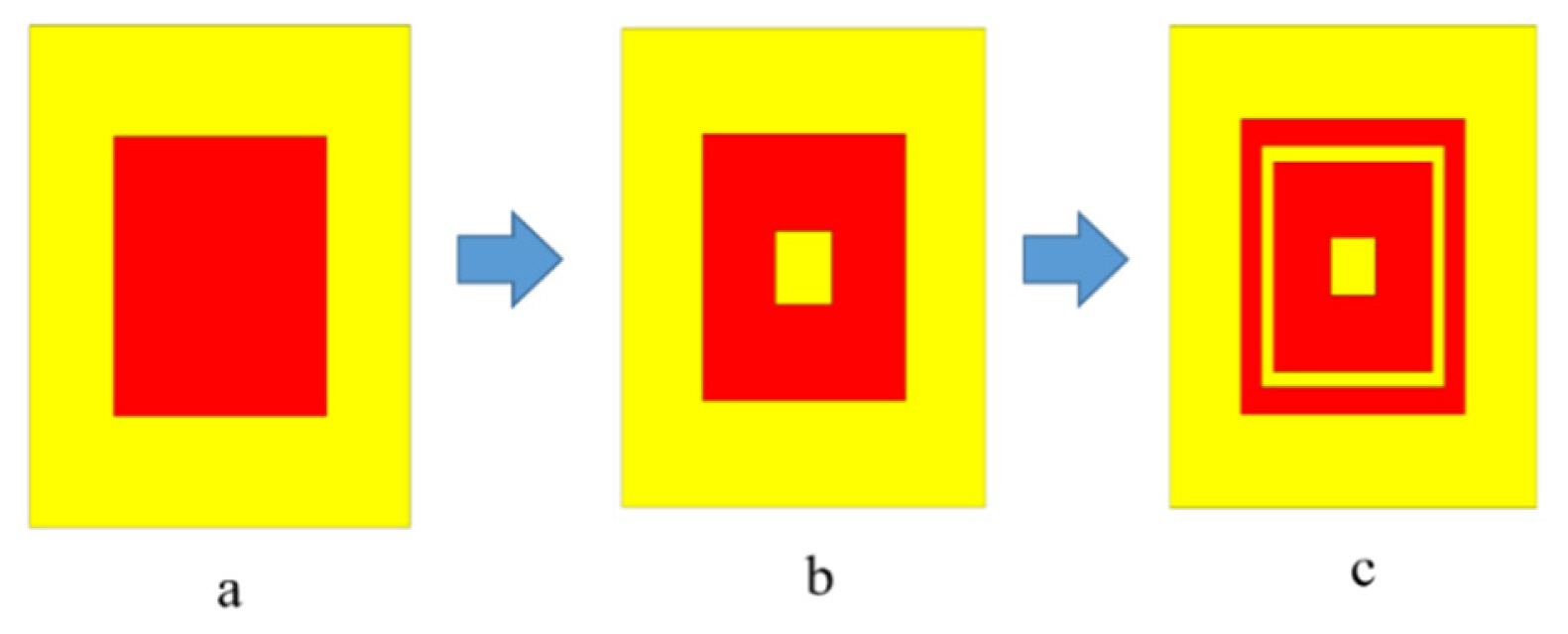
Fig. 6
Comparison of simulated radiation patterns: (a) xz-plane and (b) yz-plane at 4.3 GHz, and (c) xz-plane and (d) yz-plane at 9.8 GHz.

Fig. 15
Comparison of measured and simulated radiation patterns: (a) xz-plane and (b) yz-plane at 4.3 GHz, and (c) xz-plane and (d) yz-plane at 9.8 GHz.
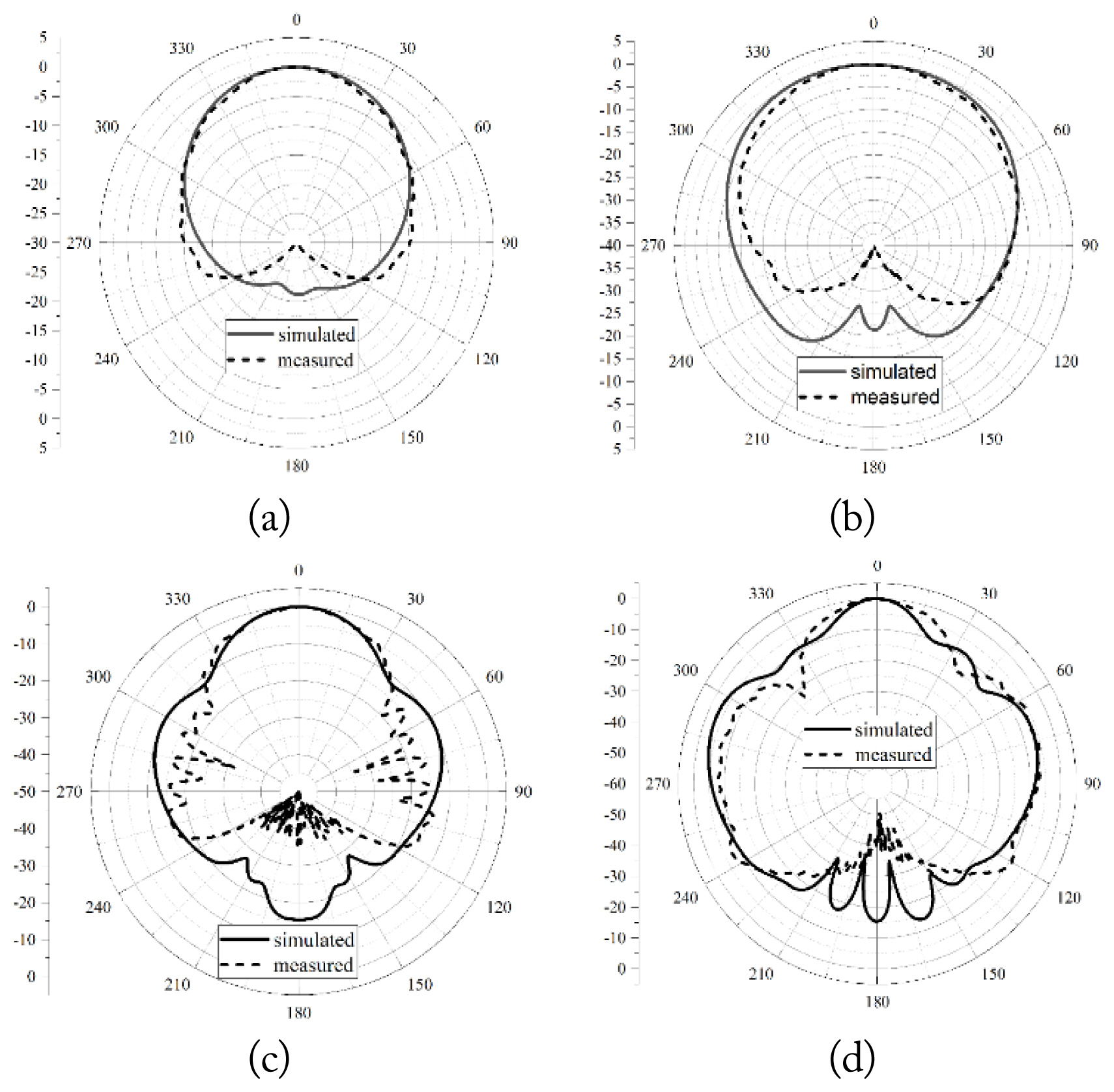
Table 1
Antenna dimensions
| Parameter | Dimension (mm) |
|---|---|
| W | 40 |
| L | 40 |
| Wp | 22 |
| Lp | 22 |
| sw | 4.35 |
| sL | 4.35 |
| S | 1.4 |
| WR | 2 |
Table 2
Comparison of our antenna with other reported studies
| Study | Band of frequency (GHz) | Dimensions of antenna | Pattern similarity achieved | Gain improvement (dB) | Pattern type (omni/directional) | Technique used |
|---|---|---|---|---|---|---|
| Rani and Pandey [2] | 4.8 and 9 | 0.84λ × 0.84λ | Yes | NA | Omni | Slot |
| Daniel et al. [16] | 3.45 and 5 | 0.6λ × 0.6λ | No | NA | Omni | Metamaterial |
| Alibakhshikenari et al. [18] | 0.4, 1.2, 2.3, 3.25, 5.2, and 6.5 | 23 mm × 17 mm | No | NA | Omni | Metamaterial |
| Haque and Alam [26] | 1.27 and 2.43 | 0.213λ × 0.213λ | No | NA | Omni | Slot |
| Anoop and Bhattacharjee [27] | 2.45 and 5.3 | 40 mm × 18 mm | No | NA | Omni | Volumetric DR |
| Islan and Das [21] | 3.5 and 5 | 0.39λ × 0.39λ | No | 2.2 | Directional | AMC with additional layer |
| Luo et al. [20] | 12.45 and 14.1 | 2.4λ × 2.4λ | Yes | 13.2 | Directional | EBG with additional layer |
| Our work | 4.3 and 9.8 | 0.58λ × 0.58λ | Yes | 12 | Directional | ENZ metamaterial |
References
1. J. R. James, P. S. Hall, and C. Wood, Microstrip Antenna: Theory and Design. London, UK: Institute of Engineering and Technology, 1981.
2. R. Boopathi Rani and S. K. Pandey, "A parasitic hexagonal patch antenna surrounded by same shaped slot for WLAN, UWB applications with notch at VANET frequency band," Microwave and Optical Technology Letters, vol. 58, no. 12, pp. 2996–3000, 2016. https://doi.org/10.1002/mop.30204

3. S. P. J. Christydass and N. Gunavathi, "Octa-band metamaterial inspired multiband monopole antenna for wireless application," Progress in Electromagnetics Research C, vol. 113, pp. 97–110, 2021. https://doi.org/10.2528/pierc21041102

4. S. Gai, Y. C. Jiao, Y. B. Yang, C. Y. Li, and J. G. Gong, "Design of a novel microstrip-fed dual-band slot antenna for WLAN applications," Progress in Electromagnetics Research Letters, vol. 13, pp. 75–81, 2010. https://doi.org/10.2528/pierl09111103

5. Y. Li, Z. Zhao, Z. Tang, and Y. Yin, "Differentially fed, dual-band dual-polarized filtering antenna with high selectivity for 5G sub-6 GHz base station applications," IEEE Transactions on Antennas and Propagation, vol. 68, no. 4, pp. 3231–3236, 2020. https://doi.org/10.1109/TAP.2019.2957720

6. L. Peng, C. L. Ruan, and X. H. Wu, "Design and operation of dual/triple-band asymmetric M-shaped microstrip patch antennas," IEEE Antennas and Wireless Propagation Letters, vol. 9, pp. 1069–1072, 2010. https://doi.org/10.1109/LAWP.2010.2091671

7. T. H. Chang and J. F. Kiang, "Compact multi-band H-shaped slot antenna," IEEE Transactions on Antennas and Propagation, vol. 61, no. 8, pp. 4345–4349, 2013. https://doi.org/10.1109/TAP.2013.2262666

8. A. K. Gautam and B. Kr Kanaujia, "A novel dual-band asymmetric slit with defected ground structure microstrip antenna for circular polarization operation," Microwave and Optical Technology Letters, vol. 55, no. 6, pp. 1198–1201, 2013. https://doi.org/10.1002/mop.27547

9. R. Singh Brar, K. Saurav, D. Sarkar, and K. Vaibhav Srivastava, "A triple band circular polarized monopole antenna for GNSS/UMTS/LTE," Microwave and Optical Technology Letters, vol. 59, no. 2, pp. 298–304, 2017. https://doi.org/10.1002/mop.30294

10. P. Garg and P. Jain, "Design and analysis of a metamaterial inspired dual band antenna for WLAN application," International Journal of Microwave and Wireless Technologies, vol. 11, no. 4, pp. 351–358, 2019. https://doi.org/10.1017/S1759078719000035

11. M. S. Majedi and A. R. Attari, "A compact and broadband metamaterial-inspired antenna," IEEE Antennas and Wireless Propagation Letters, vol. 12, pp. 345–348, 2013. https://doi.org/10.1109/LAWP.2013.2248072

12. V. G. Veselago, "Electrodynamics of substances with simultaneously negative values ε and μ," Soviet Physics Uspekhi, vol. 10, no. 4, pp. 509–514, 1968. https://doi.org/10.1070/PU1968v010n04ABEH003699

13. R. A. Shelby, D. R. Smith, and S. Schultz, "Experimental verification of a negative index of refraction," Science, vol. 292, no. 5514, pp. 77–79, 2001. https://doi.org/10.1126/science.1058847


14. M. Silveirinha and N. Engheta, "Tunneling of electromagnetic energy through subwavelength channels and bends using ε-near-zero materials," Physical Review Letters, vol. 97, no. 15, article no. 157403, 2006. https://doi.org/10.1103/PhysRevLett.97.157403

15. B. Edwards, A. Alu, M. E. Young, M. Silveirinha, and N. Engheta, "Experimental verification of epsilon-near-zero metamaterial coupling and energy squeezing using a microwave waveguide," Physical Review Letters, vol. 100, no. 3, article no. 033903, 2008. https://doi.org/10.1103/PhysRevLett.100.033903


16. R. S. Daniel, R. Pandeeswari, and S. Raghavan, "Dual-band monopole antenna loaded with ELC metamaterial resonator for WiMAX and WLAN applications," Applied Physics A, vol. 124, article no. 570, 2018. https://doi.org/10.1007/s00339-018-1985-7


17. M. M. Fakharian, M. Alibakhshikenari, C. H. See, and R. Abd-Alhameed, "A high gain multiband offset MIMO antenna based on a planar log-periodic array for Ku/K-band applications," Scientific Reports, vol. 12, article no. 4044, 2022. https://doi.org/10.1038/s41598-022-07866-1




18. M. Alibakhshikenari, B. S. Virdee, A. Ali, and E. Limiti, "Miniaturised planar-patch antenna based on metamaterial L-shaped unit-cells for broadband portable microwave devices and multiband wireless communication systems," IET Microwaves, Antennas & Propagation, vol. 12, no. 7, pp. 1080–1086, 2018. https://doi.org/10.1049/iet-map.2016.1141

19. M. Alibakhshikenari, E. Limiti, M. Naser-Moghadasi, B. S. Virdee, and R. A. Sadeghzadeh, "A new wideband planar antenna with band-notch functionality at GPS, Bluetooth and WiFi bands for integration in portable wireless systems," AEU-International Journal of Electronics and Communications, vol. 72, pp. 79–85, 2017. https://doi.org/10.1016/j.aeue.2016.11.023

20. C. W. Luo, Y. C. Jiao, G. Zhao, and G. T. Chen, "Novel low-profile dual-band and dual-polarization Fabry-Perot resonator antenna," International Journal of RF and Microwave Computer-Aided Engineering, vol. 31, no. 4, article no. e22566, 2021. https://doi.org/10.1002/mmce.22566
21. S. N. Islam and S. Das, "Dual-band CPW fed MIMO antenna with polarization diversity and improved gain," International Journal of RF and Microwave Computer-Aided Engineering, vol. 30, no. 4, article no. e22128, 2020. https://doi.org/10.1002/mmce.22128


22. S. Sahin, N. K. Nahar, and K. Sertel, "A simplified Nicolson–Ross–Weir method for material characterization using single-port measurements," IEEE Transactions on Terahertz Science and Technology, vol. 10, no. 4, pp. 404–410, 2020. https://doi.org/10.1109/TTHZ.2020.2980442

23. E. J. Rothwell, J. L. Frasch, S. M. Ellison, P. Chahal, and R. O. Ouedraogo, "Analysis of the Nicolson-Ross-Weir method for characterizing the electromagnetic properties of engineered materials," Progress in Electromagnetics Research, vol. 157, pp. 31–47, 2016. https://doi.org/10.2528/PIER16071706

24. Y. Hu, Y. J. Zhang, and J. Fan, "Equivalent circuit model of coaxial probes for patch antennas," Progress in Electromagnetics Research B, vol. 38, pp. 281–296, 2012. https://doi.org/10.2528/PIERB11121210

25. S. S. Olokede, C. A. Adamariko, and Y. M. Qasaymeh, "Equivalent circuit model of a coaxial excited microstrip-fed quasi-lumped element resonator antenna array," IET Microwaves, Antennas & Propagation, vol. 9, no. 5, pp. 446–453, 2015. https://doi.org/10.1049/iet-map.2013.0508

26. S. M. Haque and H. Alam, "Miniaturized dual-band slot antenna design for GPS, amateur radio and WLAN applications," International Journal of RF and Microwave Computer-Aided Engineering, vol. 30, no. 4, article no. e22125, 2020. https://doi.org/10.1002/mmce.22125


27. P. Anoop and R. Bhattacharjee, "Investigation on dualband equilateral triangular shaped dielectric resonator antennas for WLAN applications," International Journal of RF & Microwave Computer-Aided Engineering, vol. 31, no. 7, pp. 1–15, 2021. https://doi.org/10.1002/mmce.22672

Biography
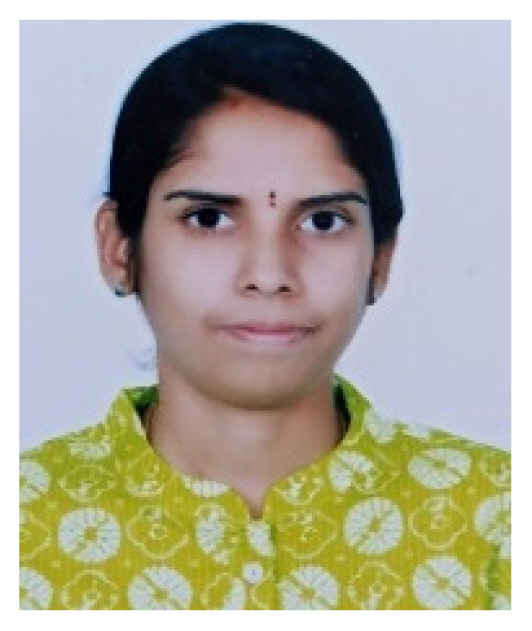
Srujana Vahini Nandigama, https://orcid.org/0000-0003-4787-6475 received her B.Tech. degree in Electronics and Communication Engineering from the Jawaharlal Nehru Technological University, Hyderabad, India, and obtained her Master of Engineering (M.E) from Anna University, Chennai, Tamilnadu, India. She was awarded a DST women scientist fellowship in 2019. She is currently a PhD fellow in the Department of ECE, Osmania University, Hyderabad, India. Her main research interests include metamaterial antennas. She has published 21 research papers in international journals/conferences.
Biography

Bharath Kunooru, https://orcid.org/0000-0002-6044-4100 received a B.Tech. degree in Electronics and Communication Engineering from Jawaharlal Nehru Technological University, Hyderabad, India, in 2011 and an M.E. degree in Microwave and Radar Engineering from Osmania University, Hyderabad, India, in 2014. He is currently a UGC Net JRF Ph.D. fellow at the Department of ECE, Osmania University, Hyderabad, India. His main research interests include printed microstrip patch antennas and millimeter wave antennas. He has published 16 research papers in international journals/conferences.
Biography

Dasari Ramakrishna, https://orcid.org/0000-0001-6336-7051 received his B.Tech. in Electronics and Communications Engineering from Sri Krishna Devaraya University, Ananthapur, Andhra Pradesh, India, and obtained his M.E. and Ph.D. in Electronics and Communication Engineering from Osmania University, Hyderabad, Telangana, India. Presently, he is working as professor and HOD for the Department of ECE, Osmania University and also serving as director for Centre for Excellence in Microwave Engineering (CEME), University College of Engineering, Osmania University. He published 65 research papers in international journals/conference proceedings. His research areas of interest include multifunction antennas and antenna systems, and microwave and millimeter-wave integrated circuits.
Biography
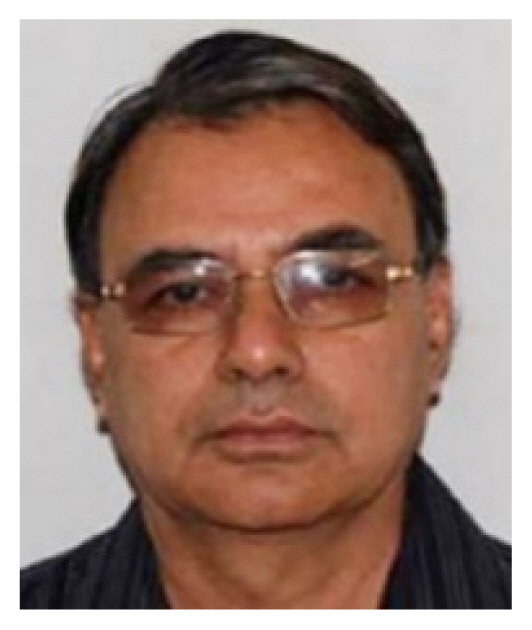
Vijay M. Pandharipande, https://orcid.org/0009-0005-0490-313X obtained his B.E. degree from Visvesvaraya National Institute of Technology, India in 1970, and M.Tech. and Ph.D. (Electronics & Communication Engineering) from Indian Institute of Technology Kharagpur, India in 1972 and 1979, respectively He worked as scientific officer in Tata Institute of Fundamental Research, Mumbai (1972–74), faculty in Radar and Communication Centre, I.I.T. Kharagpur (1974–83). He joined the Department of Electronics & Communication Engineering of Osmania University, Hyderabad as professor in 1983 and served as Head of the Department, Chairman Board of Studies, Dean Faculty of Engineering, Coordinator of two World Bank Projects, Director Curriculum Development, and Accreditation Audit Cell. He established the Centre of Excellence in Microwave. He retired as professor emeritus from Osmania University in January 2011 and served as vice-chancellor of Dr. Babasaheb Ambedkar Marathwada University, Aurangabad, India from January 2011 to March 2014. At present, he is serving as honorary director of CEME and adjunct professor at the Department of ECE, Osmania University, Hyderabad, India. He has nearly 150 research papers published in national and international journals/conference proceedings.
- TOOLS






